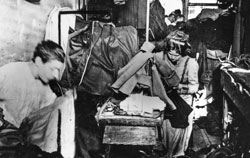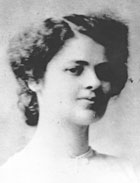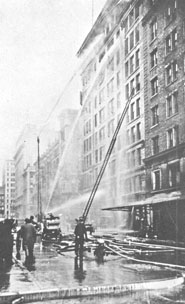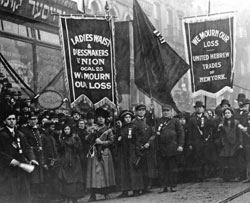Sweatshop Tragedy Ignites Fight for Workplace Safety
February 29, 2004
(This "Look Back" feature first appeared in the March/April 2004 issue of The American Postal Work Magazine.)
As women unionists struggled for better wages and working conditions, a tragic fire in New York City 93 years ago captured the nation’s attention and forever changed the course of labor history.
Although for most Americans the disaster remains part of a dim collective memory, the horrific Triangle Shirtwaist Company fire of March 25, 1911, ushered in a new chapter of the Industrial Age in which unions led the fight for workplace safety for all Americans.
The early 1900s were a dangerous time for industrial workers everywhere. Death and serious injury were considered routine occupational hazards: Mines collapsed, ships sank, boilers exploded, exposed machinery claimed life and limb. Nonetheless, workplace safety went mostly unregulated and workers’ compensation was then considered a “socialist” idea.
Sweatshop Life
One of the more notorious sweatshops was the Triangle Shirtwaist factory, New York ’s largest manufacturer of women’s blouses. Most of the factory’s 500 workers were Jewish or Italian women in their teens and early 20s who worked excessively long hours for low pay in overcrowded, dimly lit rooms on the factory’s upper floors.In New York City, exploitation in the garment industry’s factories became a harsh reality for many thousands of desperate immigrants who arrived in America seeking a better life in America at the turn of the 20th century.

Abusive factory managers used many means to “sweat” more work for less pay out of their workers: They subcontracted much of the work to agents who hired the cheapest labor available and pocketed a portion of their wages; charged workers for the needles, thread and electricity their machines used, and changed schedules or reduced wages on a whim. Workers were often threatened or fired if they complained, and union organizers were routinely beaten by hired thugs and jailed by police while the city’s political machine looked the other way.
Pay varied by age and gender regardless of the work performed, and child labor laws were seldom enforced. A typical employee worked 70 or more hours per week without overtime pay and earned about $6 — a less-than-living wage that trapped workers in the grinding poverty of the city’s crowded tenements.
Labor Responds
Several years before the fire, Local 25 of the International Ladies’ Garment Workers’ Union (ILGWU) had begun organizing workers at several of the city’s larger factories.

Though management tried to divide workers along ethnic and gender lines, the strikers remained united and won better pay, shorter hours, and union rights. The strike ended within days at some factories; Triangle’s management continued to employ scab labor until they agreed to most union demands on Feb. 8, 1910 .One union activist, Clara Lemlich, convinced 400 of her co-workers to conduct a strike at the Triangle factory in late September 1909. A few weeks later, while still recovering from a severe beating by management thugs, Lemlich delivered a rousing speech at a rally that helped convince garment workers across the city to take part in a general strike. Within days, 20,000 walked off the job, demanding a 20 percent raise, a 52-hour workweek, overtime pay, and collective bargaining rights. They also called on city leaders to institute and enforce better workplace health and safety standards.
Unfortunately, higher standards for safety and health did not come quickly enough for many Triangle workers.
Inferno
Workers dashed for the building’s inadequate stairways and elevators, which quickly became jammed. The doors to the ninth floor stairway had been locked. A main exit on the first floor had been restricted to allow only one employee to leave at a time under the watchful eye of company managers who routinely searched workers for stolen fabric scraps. Many frantic employees attempted to flee down the building’s sole fire escape, which soon collapsed. Dozens of young women plunged to their deaths on the street below as onlookers watched in horror.As workers were ending their shifts on March 25, 1911, a fire broke out on the eighth floor and climbed almost instantly up an air shaft to the floors above. Some workers attempted to douse the flames, only to find that the water supply for the fire hoses had been cut off. Within minutes, the building’s three top floors were engulfed in flames that rapidly consumed the tissue paper and cotton fabric that was used in assembling garments.

Some of the workers who were trapped waited for rescue at the building’s windows, but the fire department ladders were too short to reach them. Fire hoses could not reach the upper floors either. Many jumped to their deaths rather than be consumed by the fire.
A half-hour after the fire started, 123 young women and 23 men were dead.
Outrage Fuels Union Movement
Aided by a corrupt judge, the Triangle factory’s owners, Max Blank and Isaac Harris, escaped responsibility for the fire in a high-profile, eight-month criminal trial. The jury acquitted them because it could not be established that the owners knew that critical exit doors were locked. Three years after the fire, lawsuits eventually compensated grieving families $75 per victim. Workers cried, “Where is the justice?”The fire captivated public attention nationwide and helped usher in the Progressive Era in which “muckraking” journalists and liberal politicians exposed corruption and the abuses of corporate power. It also galvanized the union movement’s commitment to workplace safety and justice, as the ILGWU and other unions redoubled their efforts to end sweatshop exploitation.
But outrage over the disaster lead to the gradual implementation of stricter fire codes for all American dwellings and workplaces. The ILGWU’s struggle also marked the beginning of the empowerment of women workers.
In the following decades, women unionists would help lead the fight for safer workplaces, livable wages, the 40- hour work week, healthcare benefits, and gender and racial equality in the workplace. Those struggles continue — almost a century later.
Sources: Triangle: the Fire that Changed America, by David Von Drehle, Atlantic Monthly Press (2003) and Cornell University School of Industrial and Labor Relations Web exhibit,www.ilr.cornell.edu/trianglefire. Photos from UNITE Archives, Kheel Center, Cornell University



